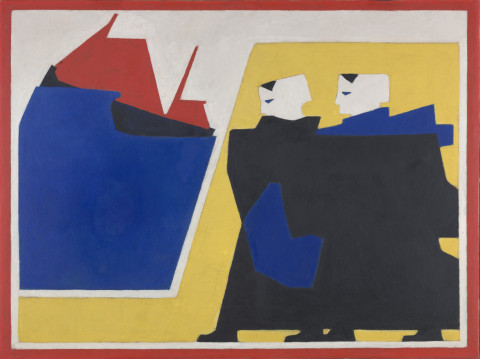
Piet Mondrian and Bart van der Leck
In 2017 it will be exactly 100 years since the launch of the Dutch art and design movement known as ‘De Stijl’. The...
Kunstmuseum Den Haag has a treasure chamber of over 160.000 pieces of art. Here we work on making the highlights from this collection available online.
The De Stijl movement was launched in Leiden exactly one hundred years ago. The Netherlands is poised to mark the centenary in 2017 with a year-long programme of events under the title Mondrian to Dutch Design. 100 years of De Stijl. Piet Mondrian is among the best-known artists involved in this international art movement. As the home both of the greatest Mondrian collection on Earth and of one of the world’s major De Stijl collections, the Gemeentemuseum will be at the forefront of festivities in 2017. Among other things, it plans to take the unprecedented and unique step of presenting its entire Mondrian collection – no fewer than 300 works – in a single, great retrospective. Come to The Hague and explore the life and work of Piet Mondrian and De Stijl as you’ve never experienced it before.
Piet Mondrian is perhaps the greatest modern artist who ever lived. Born in the Netherlands, he produced abstract paintings that took the world by storm. But his renowned abstractionism was not an overnight development. He started by painting lush green landscapes full of cows, drainage ditches and farmsteads. The skies and dunes of Zeeland prompted him to use dazzling colours and loose brushwork. Theosophy inspired other-worldly flowers and female figures. And his encounter with the Parisian avant-garde led to a more Cubist idiom. Place the glowing pictures of windmills, the colourful polder landscapes and the angular apple trees in chronological order and what you see is not only Mondrian’s personal artistic development, but the entire history of modern art unfolding before your very eyes.
In 1917, Theo van Doesburg launched a magazine called ‘De Stijl’. It was intended to provide a platform for the ideas of avant-garde artists, designers and architects. In next to no time, it attracted contributors of the calibre of Gerrit Rietveld, Bart van der Leck and Vilmos Huszár. Piet Mondrian was also involved. His abstract paintings, with their primary colour planes and black lines on a white ground, quickly became world-famous and a guiding light for the movement. The De Stijl artists were so full of their new artistic ideas that they believed they could modernise their entire world. From the chairs people sat on to the houses they lived in, and even the towns and cities they built. De Stijl expanded to become an international movement comparable to the later Bauhaus.
These two avant-garde movements have had an enormous influence on the appearance of the world around us. Then and now. De Stijl was about more than just painting. By applying its signature palette of primary colours, abstract visual idiom and emphasis on horizontal and vertical lines to architecture, interior design, furniture, fashion and advertising, the movement aimed to achieve a better and more modern society. Famous examples are Gerrit Rietveld’s Red and Blue chair, the fitted kitchens that Piet Zwart designed for Bruynzeel, Jan Wils’ Papaverhof housing complex, and Jan Duiker’s Nirwana apartment block in The Hague. De Stijl designs still crop up everywhere in the contemporary Dutch street scene. Not just that, but their formal idiom and philosophy are part of the very DNA of today’s world-famous Dutch Design movement.
For more information on the Mondrian to Dutch Design 2017 centenary year and associated events at the Gemeentemuseum Den Haag, contact: